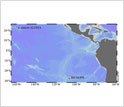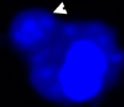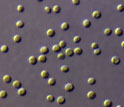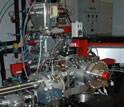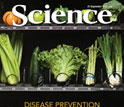News Release 12-171
Unusual Symbiosis Discovered in Marine Microorganisms
Single-celled algae and nitrogen-fixing bacteria help fertilize the oceans

Seawater sampling during an oceanographic research cruise to the southeast Pacific Ocean.
September 20, 2012
This material is available primarily for archival purposes. Telephone numbers or other contact information may be out of date; please see current contact information at media contacts.
Scientists have discovered an unusual symbiosis between tiny single-celled algae and highly specialized bacteria in the ocean.
The partnership plays an important role in fertilizing the oceans by taking nitrogen from the atmosphere and "fixing" it into a form that other organisms can use.
Details of the finding, published in this week's issue of the journal Science, emerged from the investigation of a mysterious nitrogen-fixing microbe that has a very small genome.
First detected in 1998 by Jonathan Zehr, a marine scientist at the University of California, Santa Cruz (UCSC), the microbe now appears to be the most widespread nitrogen-fixing organism in the oceans.
It belongs to a group of photosynthetic bacteria known as cyanobacteria, but it lacks the genes needed to carry out photosynthesis.
Apparently its association with the algae makes those genes unnecessary.
"The cyanobacterium is a nitrogen-fixer, so it provides nitrogen to the host cell [the algae], and the host cell provides needed carbon to the cyanobacterium, which is lacking the machinery to get its own," says Anne Thompson, a lead author of the paper and researcher at UCSC. Rachel Foster of the Max Planck Institute for Marine Microbiology is the other lead author.
The finding has uncovered a symbiosis between two types of microorganisms that had remained hidden until now, says Matt Kane, program director in the National Science Foundation's (NSF) Division of Environmental Biology, which funded the research along with NSF's Division of Ocean Sciences.
"Genomic analysis indicates that the partnership between these organisms in some ways models the one that led to the evolution of plant organelles," says Kane.
This is an interesting symbiosis from an evolutionary perspective, says Zehr, "because it can be seen as analogous to an early stage in the endosymbiosis that led to chloroplasts in plants."
Chloroplasts, which carry out photosynthesis in all plants, evolved from symbiotic cyanobacteria that eventually were incorporated into host cells in a process known as endosymbiosis.
In previous work, Zehr's team had studied the cyanobacteria in samples processed at sea and brought back to the lab.
The researchers were able to sequence the microbe's complete genome. They discovered that it's missing the genes for several key metabolic pathways, suggesting that it might live in association with another organism.
The scientists were only able to see the symbiotic partners together when they sorted freshly collected seawater samples onboard a research vessel.
"Our collaborators at the University of Hawaii, Dave Karl and Ken Doggett, put a cell sorter into a portable laboratory--a lab in a box--so now we can take the machine to sea and sort cells that minutes before were in their natural environment," says Thompson. "That's how we found the association."
Zehr noted that it's difficult to estimate the contribution of this symbiosis to global carbon and nitrogen cycles.
Other algae are more abundant and may be more important in terms of the ocean's carbon cycle than the algae hosts in this symbiosis, he says. But the cyanobacteria partners likely make this a significant contribution to global nitrogen fixation in the oceans.
"Planktonic symbioses are very difficult to study," says Foster. "The associations are often fragile. Here we used multiple tools to identify one of the first examples of this kind of partnership in plankton."
In addition to Thompson, Zehr and Foster, the co-authors of the paper include Andreas Krupke, Niculina Musat and Marcel Kuypers of the Max Planck Institute for Marine Microbiology; Brandon Carter of UCSC; and Daniel Vaulot of the Station Biologique de Roscoff and the Pierre and Marie Curie University in Paris.
The research was also funded by the Gordon and Betty Moore Foundation and the Max Planck Society.
-NSF-
-
Map of research sites in the north and south Pacific Ocean where symbioses were found.
Credit and Larger Version -
Confocal microscope images of the symbiosis.
Credit and Larger Version -
Micrograph of a small phytoplankton believed to be similar to the symbiont.
Credit and Larger Version -
Nanoscale secondary ion mass spectrometry instrument, where measurements were done.
Credit and Larger Version -
The researchers' work is described in the September 21, 2012 issue of the journal Science.
Credit and Larger Version
Media Contacts
Cheryl Dybas, NSF, (703) 292-7734, email: cdybas@nsf.gov
Tim Stephens, UCSC, (831) 459-2495, email: stephens@ucsc.edu
The U.S. National Science Foundation propels the nation forward by advancing fundamental research in all fields of science and engineering. NSF supports research and people by providing facilities, instruments and funding to support their ingenuity and sustain the U.S. as a global leader in research and innovation. With a fiscal year 2023 budget of $9.5 billion, NSF funds reach all 50 states through grants to nearly 2,000 colleges, universities and institutions. Each year, NSF receives more than 40,000 competitive proposals and makes about 11,000 new awards. Those awards include support for cooperative research with industry, Arctic and Antarctic research and operations, and U.S. participation in international scientific efforts.
Connect with us online
NSF website: nsf.gov
NSF News: nsf.gov/news
For News Media: nsf.gov/news/newsroom
Statistics: nsf.gov/statistics/
Awards database: nsf.gov/awardsearch/
Follow us on social
Twitter: twitter.com/NSF
Facebook: facebook.com/US.NSF
Instagram: instagram.com/nsfgov



